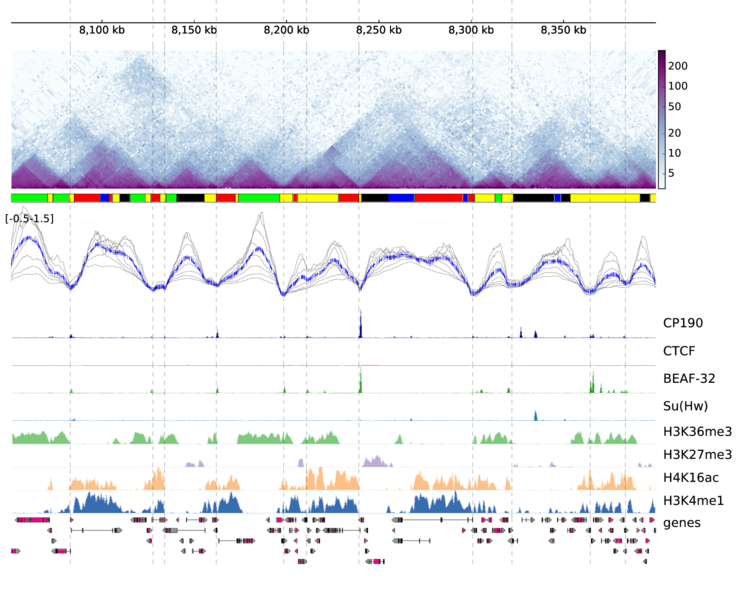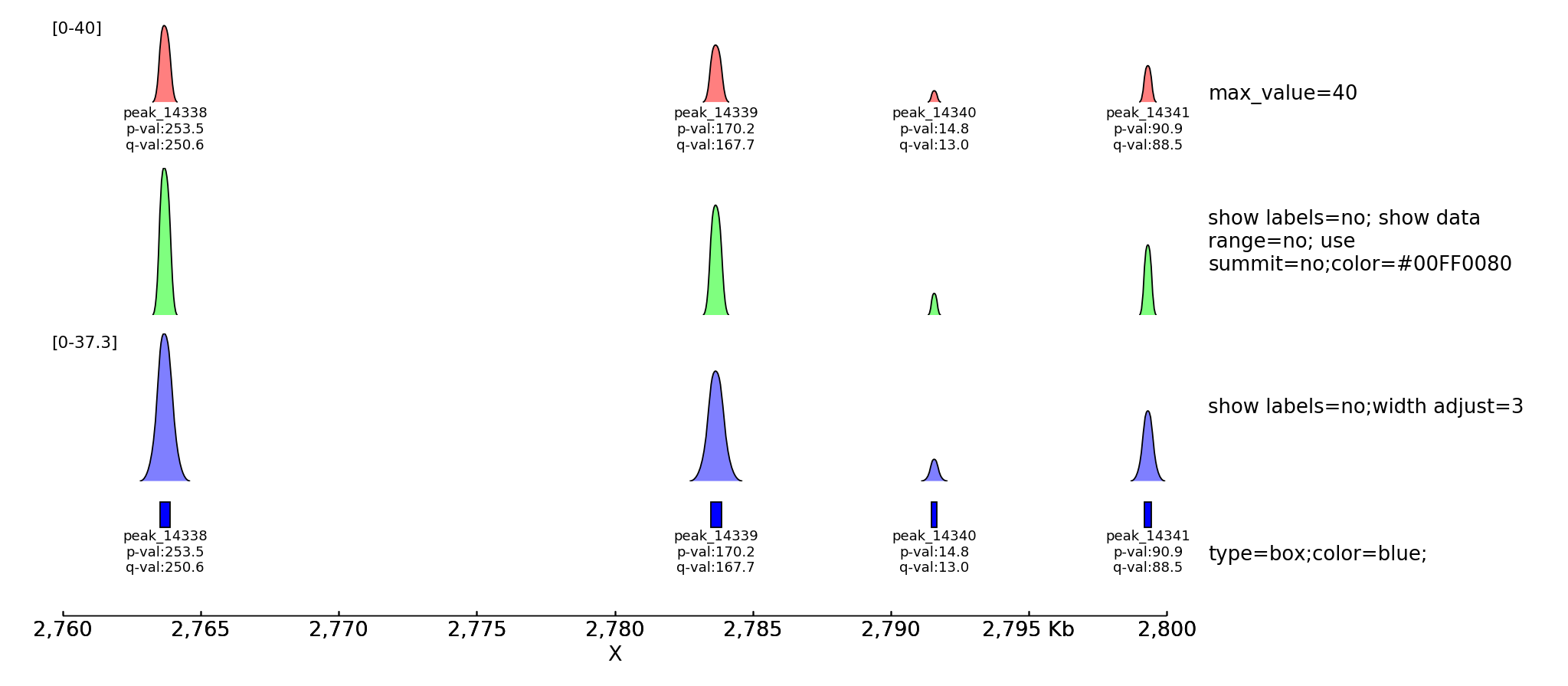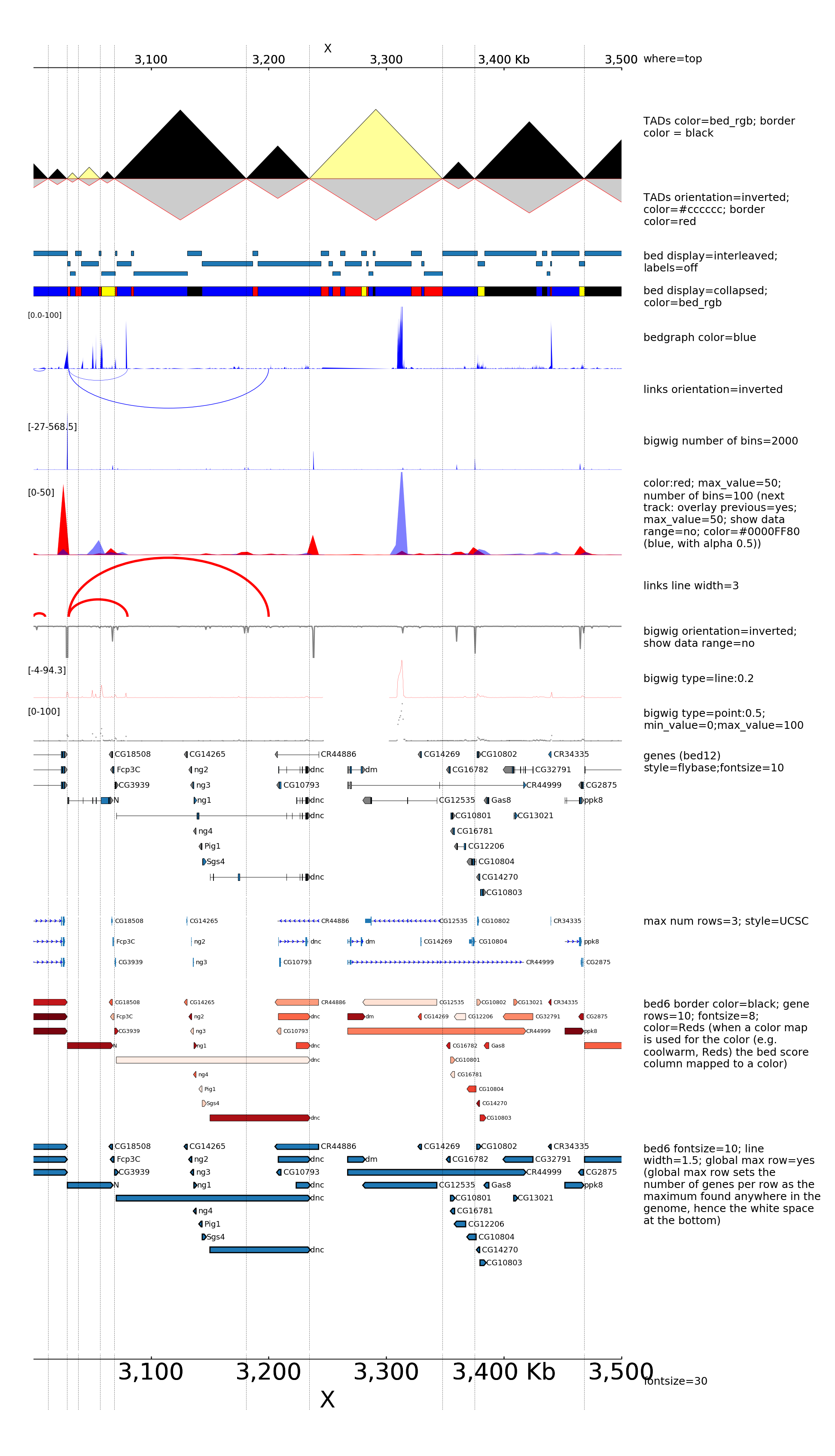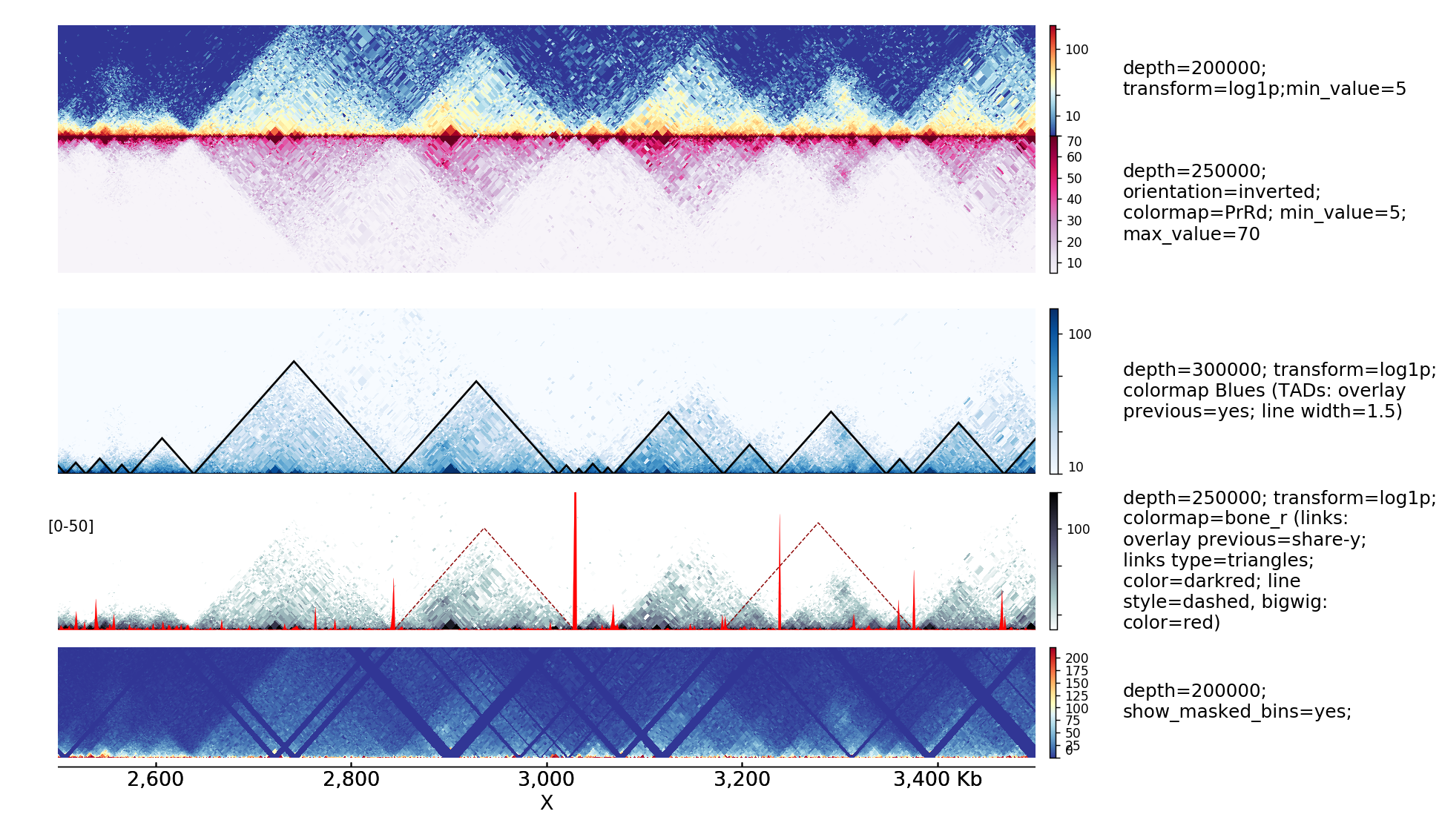pyGenomeTracks aims to produce high-quality genome browser tracks that are highly customizable. Currently, it is possible to plot:
- bigwig
- bed (many options)
- bedgraph
- links (represented as arcs)
- Hi-C matrices (if HiCExplorer is installed)
pyGenomeTracks can make plots with or without Hi-C data. The following is an example output of pyGenomeTracks from Ramírez et al. 2017
pyGenomeTracks works with python 2.7 and python 3.6.
Currently, the best way to install pyGenomeTracks is with anaconda
$ conda install -c bioconda pygenometracks Also, pyGenomeTracks can be installed using pip
$ pip install pyGenomeTracksIf the latest version wants to be installed use:
$ pip install git+https://github.com/maxplanck-ie/pyGenomeTracks.gitTo run pyGenomeTracks a configuration file describing the tracks is required. The easiest way to create this file is using the program make_tracks_file which creates a configuration file with
defaults that can be easily changed. The format is:
$ make_tracks_file --trackFiles <file1.bed> <file2.bw> ... -o tracks.inimake_tracks_file uses the file ending to guess the file type.
Then, a region can be plotted using:
$ pyGenomeTracks --tracks tracks.ini --region chr2:10,000,000-11,000,000 --outFileName nice_image.pdfThe ending --outFileName defines the image format. If .pdf is used, then the resulting image is a pdf. The options are pdf, png and svg.
(These examples are found in the examples/ folder)
A minimal example of a configuration file with a single bigwig track looks like this:
[bigwig file test]
file = bigwig.bw
# height of the track in cm (optional value)
height = 4
title = bigwig
min_value = 0
max_value = 30$ pyGenomeTracks --tracks bigwig_track.ini --region X:2,500,000-3,000,000 -o bigwig.pngNow, let's add the genomic location and some genes:
[bigwig file test]
file = bigwig.bw
# height of the track in cm (optional value)
height = 4
title = bigwig
min_value = 0
max_value = 30
[spacer]
# this simply adds an small space between the two tracks.
[genes]
file = genes.bed.gz
height = 7
title = genes
fontsize = 10
file_type = bed
gene rows = 10
[x-axis]
fontsize=10$ pyGenomeTracks --tracks bigwig_with_genes.ini --region X:2,800,000-3,100,000 -o bigwig_with_genes.pngNow, we will add some vertical lines across all tracks. The vertical lines should be in a bed format.
[bigwig file test]
file = bigwig.bw
# height of the track in cm (optional value)
height = 4
title = bigwig
min_value = 0
max_value = 30
[spacer]
# this simply adds an small space between the two tracks.
[genes]
file = genes.bed.gz
height = 7
title = genes
fontsize = 10
file_type = bed
gene rows = 10
[x-axis]
fontsize=10
[vlines]
file = domains.bed
type = vlines$ pyGenomeTracks --tracks bigwig_with_genes_and_vlines.ini --region X:2,800,000-3,100,000 -o bigwig_with_genes_and_vlines.pngpyGenomeTracks has an option to plot peaks using MACS2 narrowPeak format.
This is an example of the output:
Examples with Hi-C data
The following is an example with Hi-C data overlay with topologically associating domains (TADs) and a bigwig file.
[x-axis]
where = top
[hic matrix]
file = hic_data.h5
title = Hi-C data
# depth is the maximum distance plotted in bp. In Hi-C tracks
# the height of the track is calculated based on the depth such
# that the matrix does not look deformated
depth = 300000
transform = log1p
file_type = hic_matrix
[tads]
file = domains.bed
display = triangles
border color = black
color = none
# the tads are overlay over the hic-matrix
# the share-y options sets the y-axis to be shared
# between the Hi-C matrix and the TADs.
overlay previous = share-y
[spacer]
[bigwig file test]
file = bigwig.bw
# height of the track in cm (optional value)
height = 4
title = ChIP-seq
min_value = 0
max_value = 30
$ pyGenomeTracks --tracks hic_track.ini -o hic_track.png --region chrX:2500000-3500000A comprehensive example of pyGenomeTracks can be found as part of our automatic testing.
Note, that pyGenome tracks also allows the combination of multiple tracks into one using the parameter: overlay previous=yes or overlay previous=share-y.
In the second option the y-axis of the tracks that overlays is the same as the track being overlay. Multiple tracks can be overlay together.
The configuration file for this image is here
In these examples is where the overlay tracks are more useful. Notice that any track can be overlay over a Hi-C matrix. Most useful is to overlay TADs or to overlay links using the triangles option
that will point in the Hi-C matrix the pixel with the link contact. When overlaying links and TADs is useful to set overlay previous=share-y such that the two tracks match the positions. This is not
required when overlying other type of data like a bigwig file that has a different y-scale.
The configuration file for this image is here
Adding new tracks to pyGenomeTracks only requires adding a new class that has a plot method and defines some basic info.
For example, to make a track that plots some text at a given location we need to make class that looks like this:
class TextTrack(GenomeTrack):
SUPPORTED_ENDINGS = ['.txt'] # this is used to guess the type of track based on file name
TRACK_TYPE = 'text'
OPTIONS_TXT = """
height = 3
title =
text =
# x position of text in the plot (in bp)
x position =
"""
def plot(self, ax, label_ax, chrom, region_start, region_end):
# print text at position x = self.properties['x position'] and y = 0.5 (center of the plot)
ax.text(float(self.properties['x position']), 0.5, self.properties['text'])
# print title in legend axis
label_ax.text(0.15, 0.5, self.properties['title'])
Now we make a configuration file.
[x-axis]
where = top
[new track]
file =
height = 4
title = new pyGenomeTrack
file_type = text
text = hello world
x position = 3100000pyGenomeTracks is used by HiCExporer and HiCBrowser (See e.g. Chorogenome navigator which is made with HiCBrowser)











